Bone conduction hearing aid system
a hearing aid and bone technology, applied in the field of bilateral fittings, can solve the problems of unnatural interference of sound, deterioration of itds and ilds, and limited benefit of bilateral fittings, and achieve the effect of preserving binaural effects
- Summary
- Abstract
- Description
- Claims
- Application Information
AI Technical Summary
Benefits of technology
Problems solved by technology
Method used
Image
Examples
Embodiment Construction
[0022]FIG. 1 shows a block diagram of an example of a bone conduction hearing aid system according to the invention, comprising a right ear hearing aid 10A and a left ear hearing aid 10B. The right ear hearing aid 10A comprises a microphone arrangement 12A for capturing audio signals from ambient sound, an audio signal processing unit 14A for processing the audio signals captured by the microphone arrangement 12A and a bone conduction output transducer 16A. The right ear hearing aid 10A also comprises a filter unit 18A for generating a right ear cross-talk compensation signal from the processed audio signals of the right ear audio signal processing unit 14A, according to an estimated transcranial transfer function from the right ear bone conduction output transducer 16A to the left ear cochlea 20B and an adder unit 22A for adding a left ear cross talk compensation signal received from the left ear hearing aid 10B to the processed audio signals produced by the right ear audio signal ...
PUM
 Login to View More
Login to View More Abstract
Description
Claims
Application Information
 Login to View More
Login to View More - R&D
- Intellectual Property
- Life Sciences
- Materials
- Tech Scout
- Unparalleled Data Quality
- Higher Quality Content
- 60% Fewer Hallucinations
Browse by: Latest US Patents, China's latest patents, Technical Efficacy Thesaurus, Application Domain, Technology Topic, Popular Technical Reports.
© 2025 PatSnap. All rights reserved.Legal|Privacy policy|Modern Slavery Act Transparency Statement|Sitemap|About US| Contact US: help@patsnap.com



